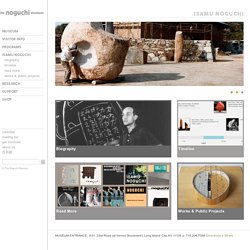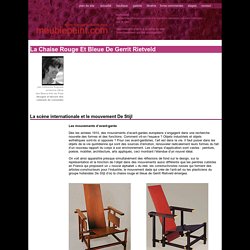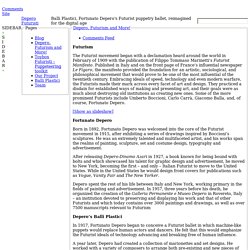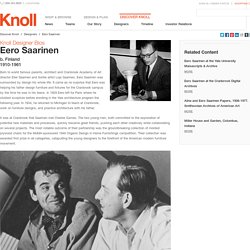

Barber & Osgerby. The Noguchi Museum. Noguchi slide 1 Noguchi slide 2 Noguchi slide 3.

Jongeriuslab design studio. Harry Bertoia. Hans gugelot. La chaise rouge et bleue de gerrit rietveld. Une chaise confortable ?

Une belle chaise ? 1/ Une belle chaise : géométrie anguleuse et pure ? Rietveld utilise une grammaire séduisante des lignes : - un empilement de verticalité et d’horizontalité pour les barreaux, soit une géométrie facile à comprendre, - au sein duquel le dossier et l’assise semblent en équilibre précaire, c’est-à-dire la création d’un monde légèrement décalé. Et nous restons étonné par le « Comment tout cela peut-il tenir ? ». D’autre part, la peinture permet de contredire efficacement l’effet compact de la chaise tout en rappelant bien la fonction : le dossier et l’assise sont parfaitement visibles tandis que le noir « dissimule » les barreaux. 2/ Y-a-t-il une idée de confort ? Les caractéristiques ergonomiques de la chaise laissent présumer l’idée de confort : - un dossier incliné à 25° par rapport à la verticale, - une assise inclinée à près de 10° par rapport à l’horizontale. 3/ Plus qu’un meuble, n’est-ce pas une vision purement plastique ? George Nelson (1908-1986), USA: Designer: George Nelson Design Archive.
Dorothee Becker. Depero Futuristi » Depero, Futurism and More! Futurism The Futurist movement began with a declamation heard around the world in February of 1909 with the publication of Filippo Tommaso Marinetti’s Futurist Manifesto.

Published in Italy and on the front page of France’s influential newspaper Le Figaro, the manifesto provided the foundation for an artistic, sociological, and philosophical movement that would prove to be one of the most influential of the twentieth century. Embracing ideals of speed, technology and even modern warfare, the Futurists made their mark across every facet of art and design. They practiced a disdain for established ways of making and presenting art, and their goals were as much about destroying old institutions as creating new ones.
Some of the more prominent Futurists include Umberto Boccioni, Carlo Carrà, Giacomo Balla, and, of course, Fortunato Depero. Fortunato Depero Depero spent the rest of his life between Italy and New York, working primary in the fields of painting and advertisement. Le dossier pédagogique Ettore Sottsass et le design italien. Knoll. Born to world famous parents, architect and Cranbrook Academy of Art director Eliel Saarinen and textile artist Loja Saarinen, Eero Saarinen was surrounded by design his whole life.

It came as no surprise that Eero was helping his father design furniture and fixtures for the Cranbrook campus by the time he was in his teens. In 1929 Eero left for Paris where he studied sculpture before enrolling in the Yale architecture program the following year. In 1934, he returned to Michigan to teach at Cranbrook, work on furniture designs, and practice architecture with his father. It was at Cranbrook that Saarinen met Charles Eames. The two young men, both committed to the exploration of potential new materials and processes, quickly became great friends, pushing each other creatively while collaborating on several projects. Charles Eames and Eero Saarinen with a lightweight tensile structure designed for the 1939 faculty exhibition at the Cranbrook Academy of Art Architecture Studio. Studio D'Urbino Lomazzi. Charles & Ray Eames.
Charles Eames, né en 1907 à Saint Louis, dans le Missouri, étudie l’architecture à l’université Washington de Saint Louis et ouvre son propre cabinet d’architecture en 1930 avec Charles M.

Gray. En 1935, il crée un nouveau cabinet d’architecture avec Robert T. Walsh. Après avoir reçu une bourse de l'Académie des Arts de Cranbrook en 1938, il vient s'installer dans le Michigan où il deviendra professeur un an plus tard. En 1940, il remporte avec Eero Saarinen le premier prix du concours de design « Organic Design in Home Furnishings » du Museum of Modern Art de New York. Ray Eames, née Bernice Alexandra Kaiser en 1912 à Sacramento en Californie, étudie la peinture au Bennett College de Millbrook à New York. De 1941 à 1943, Charles et Ray Eames conçoivent et développent des brancards et des attelles en contreplaqué moulé, et en 1946 ils exposent leurs réalisations expérimentales en contreplaqué moulé au Museum of Modern Art à New York.
Arne Jacobsen - Arne Jacobsen. Alfredo Häberli Design Development. Vivienne Westwood.